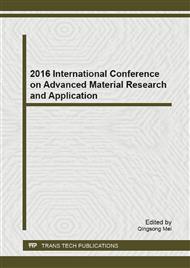[1]
I.B. Cadoef, E. Miller, Thermoelectric Materials and Device, Reinhold, New York, (1960).
Google Scholar
[2]
D.M. Rowe, C.M. Bhandari, Modern Thermoelectrics, Reston, VA, (1983).
Google Scholar
[3]
F. Ioefe, Semiconductors Thermoelements and Thermoelectric Cooling, Interscince, New York-London, (1961).
Google Scholar
[4]
C. Wood, Materials for thermoelectric energy conversion, Rep. Prog. Phys. 51 (1988) 459-539.
Google Scholar
[5]
E.B. Lon, Cooling, heating, generating power, and recovering waste heat with thermoelectric systems, Science 321 (2008) 1457-1461.
DOI: 10.1126/science.1158899
Google Scholar
[6]
F.J. Disalvo, Thermoelectric cooling and power generation, Science 285 (1999) 703-706.
DOI: 10.1126/science.285.5428.703
Google Scholar
[7]
H.J. Goldsmid, Thermoelectric Refrigeration, Plenum, New York, (1964).
Google Scholar
[8]
D.M. Rowe, CRC Handbook of Thermoelectrics, CRC, Boca Raton, (1995).
Google Scholar
[9]
T.M. Tritt, Recent Trends in Thermoelectric Materials Research III, Academic, San Diego, (2001).
Google Scholar
[10]
D.D. Pollok, Thermocouples: Theory and Properties, CRC, Boca Raton, (1991).
Google Scholar
[11]
B.C. Sales, Smaller is cooler, Science 295 (2002) 1248-1249.
Google Scholar
[12]
G. Mahan, B. Sales, J. Sharp, Thermoelectric materials: new approaches to an old problem, Phys. Today 50 (2008) 42-47.
DOI: 10.1063/1.881752
Google Scholar
[13]
C.B. Vining, A model for the high-temperature transport properties of heavily doped n-type silicon-germanium alloys, J. Appl. Phys. 69 (1991) 331-334.
DOI: 10.1063/1.347717
Google Scholar
[14]
J. Yang, T. Caillat, Thermoelectric materials for space and automotive power generation, MRS Bull. 31 (2006) 224-229.
DOI: 10.1557/mrs2006.49
Google Scholar
[15]
G.S. Nolas, J. Poon, M. Kanatzidis, Recent developments in bulk thermoelectric materials, MRS Bull. 31 (2006) 199-205.
DOI: 10.1557/mrs2006.45
Google Scholar
[16]
D.M. Rowe, Thermoelectrics, an environmentally-friendly source of electrical power, Renew. Energ. 16 (1999) 1251-1256.
DOI: 10.1016/s0960-1481(98)00512-6
Google Scholar
[17]
D.M. Rowe, Thermoelectrics Handbook: Macro to Nano, CRC/Taylor & Francis, Boca Raton, (2006).
Google Scholar
[18]
T.M. Tritt, M.A. Subramanian, Thermoelectric materials, phenomena, and applications: a bird's eye view, MRS Bull. 31 (2006) 188-198.
DOI: 10.1557/mrs2006.44
Google Scholar
[19]
H.J. Goldsid, G.S. Nolas, A review of the new thermoelectric materials, in: Proc. 20th Inter. Conf. Thermoelectrics, Beijing, R.P. China, Jun 8-11 2001, pp.1-6.
Google Scholar
[20]
G.S. Nolas, J.L. Cohn, G.A. Slack, S.B. Schujman, Semiconducting Ge clathrates: Promising candidates for thermoelectric applications, Appl. Phys. Lett. 73 (1998) 178-180.
DOI: 10.1063/1.121747
Google Scholar
[21]
B.C. Sales, B.C. Chakoumakos, R. Jin, J.R. Thompson, D. Mandrus, Structural, magnetic, thermal, and transport properties of X8Ga16Ge30 (X=Eu, Sr, Ba) single crystals, Phys. Rev. B 63 (2001) 245113.
Google Scholar
[22]
Y. Jiang, F. Bridges, M.A. Avila, T. Takabatake, J. Guzman, G. Kurczveil, EXAFS study of n- and p-type Ba8Ga16Ge30, Phys. Rev. B 78 (2008) 014111.
Google Scholar
[23]
H. Schäfer, On the problem of polar intermetallic compounds: the stimulation of E. Zintl's work for the modern chemistry of intermetallics, Annu. Rev. Mater. Sci. 15 (1985) 1-42.
DOI: 10.1146/annurev.ms.15.080185.000245
Google Scholar
[24]
X. Yan, M. X. Chen, S. Laumann, E. Bauer, P Rog, R. Podloucky, S. Paschen, Thermoelectric properties of Ba-Cu-Si clathrates, Phys. Rev. B 85 (2012) 165127.
DOI: 10.1103/physrevb.85.165127
Google Scholar
[25]
X. Yan, A. Grytsiv, G. Giester, E. Bauer, P. Rogl, S. Paschen, Single-crystal investigations on quaternary clathrates Ba8Cu5SixGe41-x (x=6, 18, 41), J. Electron. Mater. 40 (2011) 589-596.
DOI: 10.1007/s11664-010-1464-1
Google Scholar


